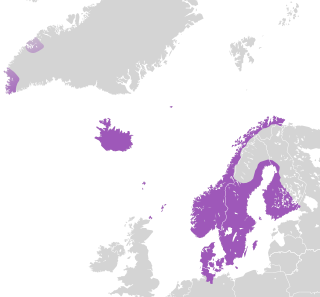
The Kalmar Union was a personal union in Scandinavia, agreed at Kalmar in Sweden as designed by Queen Margaret of Denmark. From 1397 to 1523, it joined under a single monarch the three kingdoms of Denmark, Sweden, and Norway, together with Norway's overseas colonies.

The Stockholm Bloodbath was a trial that led to a series of executions in Stockholm between 7 and 9 November 1520. The event is also known as the Stockholm massacre.
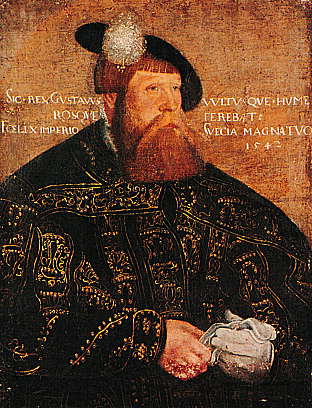
Gustav Eriksson Vasa, also known as Gustav I, was King of Sweden from 1523 until his death in 1560. He was previously self-recognised Protector of the Realm (Riksföreståndare) from 1521, during the ongoing Swedish War of Liberation against King Christian II of Denmark, Norway and Sweden. Gustav rose to lead the Swedish War of Liberation following the Stockholm Bloodbath, where his father was executed. Gustav's election as king on 6 June 1523 and his triumphant entry into Stockholm eleven days later marked Sweden's final secession from the Kalmar Union.

Christian I(Christiern I) was a German noble and Scandinavian monarch under the Kalmar Union. He was king of Denmark (1448–1481), Norway (1450–1481) and Sweden (1457–1464). From 1460 to 1481, he was also duke of Schleswig and count of Holstein. He was the first king of the House of Oldenburg.
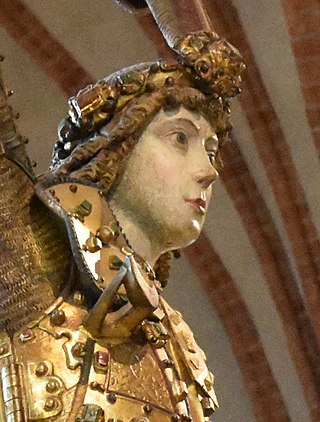
Sten Sture the Elder was a Swedish statesman and regent of Sweden from 1470 to 1497 and again from 1501 to 1503. As the leader of the victorious Swedish separatist forces against the royal unionist forces during the Battle of Brunkeberg in 1471, he weakened the Kalmar Union considerably and became the effective ruler of Sweden as Lord Regent for most of his remaining life.

Kettil Karlsson (Vasa) (c. 1433 – 11 August 1465) was a Swedish clergyman, diplomat, military leader and statesman during the Kalmar Union era. He was a member of the house of Vasa. At age 25, he was elected Bishop of Linköping. He rebelled against King Christian I in 1463, was Captain General (rikshövitsman) and de facto regent of Sweden from February to August 1464, stepping down during the brief return of King Charles Canutesson from exile. After falling out with King Charles, Kettil Karlsson was subsequently elected Lord Protector and Regent (riksföreståndare) of Sweden from 26 December 1464 to his death.
Sture was a name borne by three distinct but interrelated noble families in Sweden in the Late Middle Ages and Early Modern Period. It was originally a nickname, meaning 'haughty, proud', but later became a surname. Particularly famous are the three regents from these families who ruled Sweden in succession during the fifty-year period between 1470 and 1520, namely:

Christina Nilsdotter Gyllenstierna of Fogelvik was a Swedish noblewoman. She was married to the Swedish regent Sten Sture the Younger, and led the Swedish resistance against Christian II of Denmark after the death of her spouse. In her own lifetime she was simply referred to as Fru Kristina, but she has become known in history as Kristina Gyllenstierna because of the house of nobility to which she belonged.
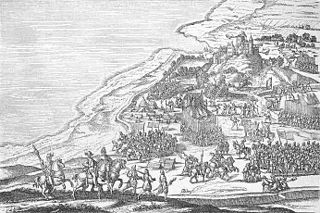
The Northern Seven Years' War was fought between the Kingdom of Sweden and a coalition of Denmark–Norway, Lübeck, and Poland–Lithuania between 1563 and 1570. The war was motivated by the dissatisfaction of King Frederick II of Denmark with the dissolution of the Kalmar Union, and the will of King Eric XIV of Sweden to break Denmark's dominating position. The fighting continued until both armies had been exhausted, and many men died. The resulting Treaty of Stettin was a stalemate, with neither party gaining any new territory.

The Battle of Brunkeberg was fought on 10 October 1471 between the Swedish regent Sten Sture the Elder and forces led by Danish king Christian I. Sture won a decisive victory.

The Russo-Swedish War of 1495–1497, known in Sweden as the Stures' Russian War, in Russia First Swedish War, was a border war which occurred between the Grand Duchy of Moscow and the Kingdom of Sweden. Although the war was relatively short, and did not lead to any territorial changes, it has significance as the first war between Sweden and Moscow. Sweden earlier fought wars against the Novgorod Republic, before Novgorod was formally annexed to Moscow in 1478.

Ingeborg Åkesdotter Tott, in her lifetime called Ingeborg Åkesdotter or simply Fru Ingeborg, was a Swedish noble and the consort of the Swedish regent Sten Sture the Elder. She was the fiefholder of Häme in Finland. She functioned as the de facto queen consort of Sweden for over three decades and participated in state affairs during the reign of her spouse.
Knut Jönsson Posse was a Swedish general in Sweden and Finland remembered for the Vyborg Bang (1495) and for his surprise attack on the Danish Army at the Battle of Brunkeberg (1471).
Nils Bosson Sture (1426–1494) was a Swedish noble and supporter of Sten Sture to be King of Sweden. He is famous for his flanking movement to surprise King Christian I of Denmark's army at the Battle of Brunkeberg in 1471. He died as a politician in the Swedish government in Stockholm, a proud man.

The Battle of Brännkyrka took place on 27 July 1518 in Sweden, during a Swedish uprising against the Danish dominance in Kalmar Union, between Danish forces and Swedish rebel troops. The battle resulted in decisive Swedish victory.
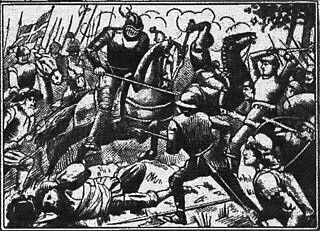
The Dano-Swedish War from 1501 to 1512 was a military conflict between Denmark and Sweden within the Kalmar Union.
The Battle of Haraker was fought on 17 April 1464 at the village of Haraker, Västmanland, approximately 20 kilometers north of the city of Västerås in Sweden. The Swedish separatist army, under the command of the Bishop of Linköping, Kettil Karlsson, defeated King Christian I's Danish army.

Events from the year 1520 in Sweden.

The Viborg Bang, as it is traditionally called in Swedish historiography, was a possibly legendary explosion which occurred at Viborg Castle in November 1495. It occurred during an assault on the castle by forces of the Grand Duchy of Moscow and is supposed to have had a crushing effect upon the morale of the besiegers, causing the attack to fail.

The Dano-Swedish War (1512–1520), is the name of the conflict that lasted 1512–1520 and was part of the Union Wars at the time of the Kalmar Union. The war was between the opponents of the union and the Danish king Hans, later his son Christian II, and ended in 1520 after Sten Sture the Younger died as a result of injuries at Battle of Bogesund and Christian II marched into Stockholm in September of the same year.

















